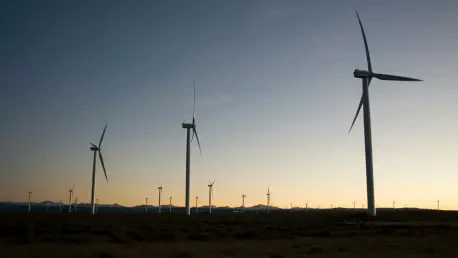In the midst of climate change challenges, urban centers are eagerly seeking effective solutions for integrating renewable energy sources into their landscapes. The emergence of Dragonfly Turbines, a groundbreaking innovation, presents a compelling proposition for the transformation of urban renewable energy systems. Developed through a collaboration between ENEL Green Power and architect Renzo Piano, these turbines are inspired by the unique flight mechanics of dragonflies. The technology promises to address common hurdles faced in urban settings, such as spatial constraints and variable wind conditions. As urban populations grow and energy demands increase, Dragonfly Turbines offer a potential breakthrough, challenging conventional energy paradigms while seeking to align functionality with aesthetic integration.
Innovative Design and Technical Distinctions
The Dragonfly Wind Turbine’s engineering marvel lies in its departure from traditional three-blade designs, featuring two lightweight blades made from advanced materials like polycarbonate and carbon. This design enables the turbine to efficiently harness wind at speeds as low as 6.56 feet per second, a feat that traditional turbines struggle to achieve. The significance of this low-speed operational capability cannot be overstated in urban areas, where wind availability is often compromised by the built environment. Furthermore, the Dragonfly Turbine’s innovative design incorporates the principles of a dragonfly’s flight, which allows the turbine to capture wind from all directions and maintain stable energy output despite fluctuating conditions. This characteristic provides a distinct advantage, as it ensures consistent energy generation, critical for meeting the unpredictable power needs of bustling urban settings.
Beyond its technical performance, the Dragonfly Wind Turbine champions a thoughtful approach to visual and environmental integration. Standing at about 65.6 feet with a blade diameter of 52.49 feet, its slender profile minimizes visual intrusion, a major consideration in densely populated areas concerned with preserving aesthetics and minimizing structural obtrusiveness. The design prioritizes noise reduction and wildlife safety, addressing pre-existing criticisms leveled at larger, noisier turbines that jeopardize local fauna. This sensitivity to environmental and community needs reflects a sophisticated understanding of what modern urban developments require: solutions that fulfill energy requirements while maintaining harmony with surroundings.
Environmental Impact and Applications
From an environmental perspective, the Dragonfly Wind Turbine represents a pivotal advancement in sustainable urban living. It embodies a shift towards integrating renewable technologies in a manner that respects ecological boundaries and diminishes adverse impacts associated with traditional energy sources. Key to this shift is the turbine’s silent operation and wildlife-friendly features, pivotal factors in gaining acceptance from urban communities often skeptical of large-scale wind farms. In moving away from conventional energy generation methods, this technology plays a role in promoting cleaner air and reducing carbon footprints, vital components in the global fight against climate change.
The turbine’s adaptability makes it suitable for various urban applications, from residential rooftops to commercial complexes, each contributing to decentralized energy networks. Such versatility supports a diversified approach to energy sourcing, a crucial element for cities aiming to reduce reliance on centralized grids. The production capabilities were proven during the testing phase, where the prototype generated over 1,241.02 kW-hours of electricity in two months, seamlessly integrating it into the grid. This proficiency in diverse environments underscores the potential of such innovations to lead the way towards renewable urban landscapes, setting precedents for future implementations.
Urban Integration and Cultural Shift
The Dragonfly Wind Turbine’s potential goes beyond just technical capabilities; it promises to embed itself seamlessly into increasingly renewable-focused urban environments. As cities strive to attain sustainability targets, urban planners and policymakers face the challenge of integrating technologies that align with architectural and cultural ethos. Unlike traditional wind turbines that may encounter resistance due to their cumbersome presence, Dragonfly Turbines offer an aesthetically pleasing alternative that harmonizes with urban landscapes, potentially easing community adoption processes.
Furthermore, this development signifies a crucial cultural shift towards appreciating nature-inspired solutions as legitimate pathways to achieving energy independence and ecological balance. The Dragonfly Turbine’s capacity to bridge the gap between functionality and design serves as an exemplar of how new technologies can redefine urban dynamics. By taking inspiration from nature, specifically the anatomy of dragonflies, it reinforces the notion that future cityscapes can be designed with sustainable utilities at their core. The technology sets a new standard for how urban communities can intertwine progress with nature, in turn fostering environments that recognize the need for environmental stewardship as a complement to urban advancement.
Reflecting on Future Prospects
The engineering innovation of the Dragonfly Wind Turbine lies in its break from the conventional three-blade models. It boasts two lightweight blades crafted from advanced materials like polycarbonate and carbon. This design efficiently captures wind at speeds as low as 6.56 feet per second, outperforming traditional turbines, which often struggle in such conditions. This low-speed capability is vital for urban environments, where wind flow is frequently hampered by buildings. Additionally, the turbine’s unique design draws inspiration from a dragonfly’s flight, enabling it to receive wind from every direction. Consequently, it maintains a steady energy output despite variable conditions, which is crucial for the unpredictable energy demands of busy urban centers.
Moreover, the Dragonfly Turbine excels at environmental integration. At around 65.6 feet tall with a blade span of 52.49 feet, its slim design reduces visual impact. Noise reduction and wildlife protection are prioritized, addressing issues faced by older, louder turbines that endangered local wildlife. This approach demonstrates a nuanced understanding of the need for energy solutions that respect urban environments without sacrificing efficiency or sustainability.









